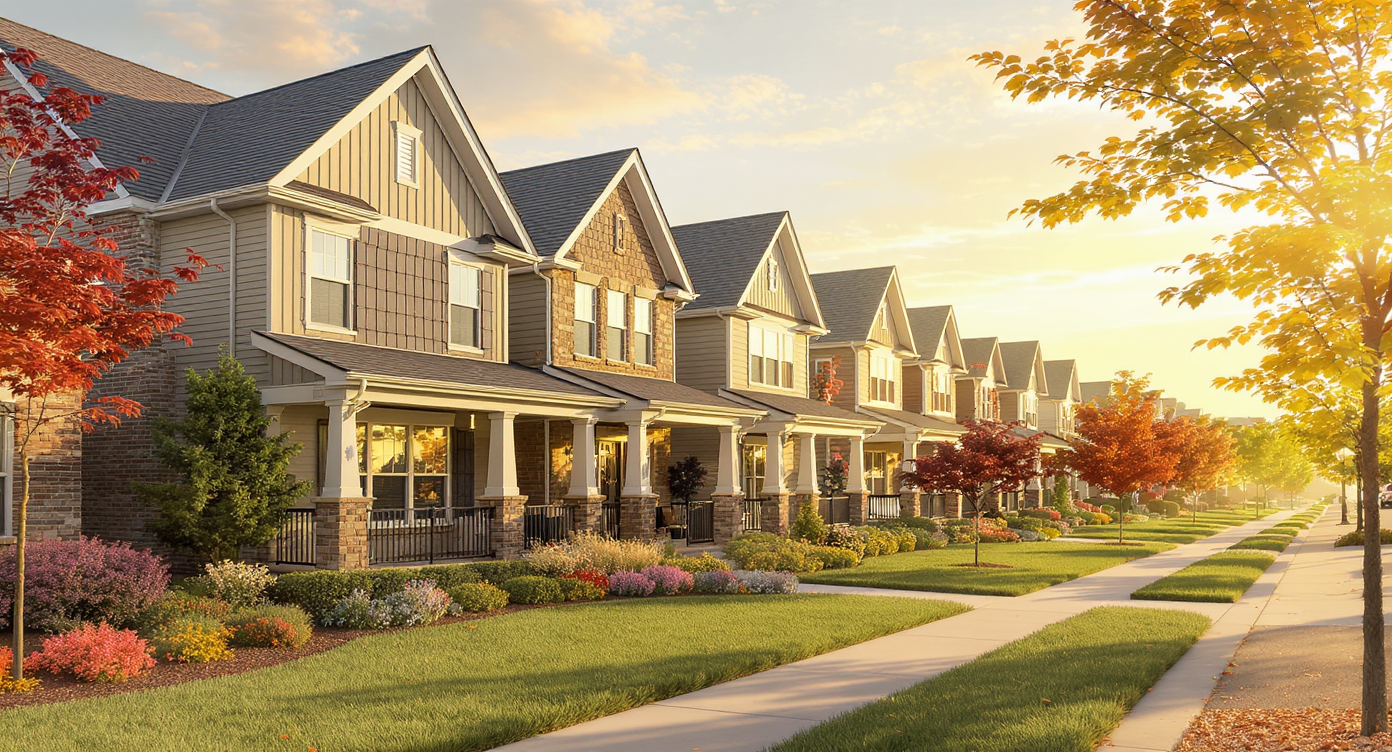TL;DR
Door knocking for real estate agents can work—when it’s hyperlocal, value-first, and tied to a listing or market update. Most agents see better, safer ROI by pairing neighbor invites and door hangers with digital farming, open house marketing, and consistent follow-up. If you’re asking how to get real estate leads without door knocking, build a permission-based engine that scales online and in the community.
Door knocking divides agents. Here’s a data-backed guide to safer, value-first real estate lead generation that builds listings in 2025.

A modern home office reflects the blend of digital tools and personal outreach in today's real estate marketing.
In real estate lead generation, few topics split the room like door knocking. Some agents credit it with their first listings and early momentum. Others argue it’s intrusive, risky, and out of step with how people want to be approached in 2025.
Here’s the thing: buyers and sellers live online now. Industry surveys show most homebuyers start their search on the internet, and agents report a sizable share of listing appointments originating from digital touchpoints. At the same time, neighbors still care deeply about what’s happening on their block. That gap is your opportunity—if you treat door knocking not as a cold pitch, but as a way to deliver timely, hyperlocal value.
The best real estate marketing blends both worlds. Use targeted neighbor outreach when you have a clear reason to show up—then scale trust with consistent, respectful follow-up across email, social, and open house events.
The direct answer: door knocking can work—if you stop “selling” and start offering value
Real estate lead generation works best when your outreach answers a specific neighborhood question: what’s selling, for how much, and how it affects me. Agents often advise limiting door knocking to “just listed,” “open house,” or “just sold” announcements within a defined radius. You’re not asking for a listing—you’re giving information and an invite.
“Neighbors love to know first.” Agents who pair a quick knock with open house invites often report higher attendance—frequently doubling turnout compared with online-only promotion—because locals bring friends and family who already want into the community.
- What to bring: a one-page market update, a neighbor-only invite, and a QR code to a digital property page. Alt text for your flyer image: “Agent inviting neighbors to a private preview open house.”
- Where to focus: 100–200 doors within a half-mile of your listing, or a well-defined HOA or condo stack.
- What to say: “I’m hosting a neighbor preview Saturday 11–12. Thought you might want the first look and a market update for your street.”
Agents often report that consistent, value-first knocking around listings produces warmer conversations and referral intel (who’s thinking about downsizing, who has a friend trying to move in) without feeling like a hard sell. Pair that with digital farming—neighborhood email updates with real comps and days-on-market—and you now have a list you can nurture month after month.
Anecdote
A rookie agent farmed a single 800-door neighborhood with monthly updates, quarterly neighbor previews, and respectful door hangers. It took nine months to close the first deal, then referrals surged; by year two, most listings came from that farm.
Common mistakes that make door knocking feel intrusive (and how to fix them)
Door knocking for real estate backfires when it’s random, salesy, or insensitive to safety and privacy. A few missteps can tank your local reputation faster than a bad ad campaign.
“Respect is your conversion advantage.” Market analysts suggest that permission-first outreach outperforms pure cold prospecting over a 6–12 month horizon because it compounds trust and referrals.
- Cold knocking with no context: Don’t show up asking, “Thinking of selling?” Show up with a purpose: an invite, a comp update, or a neighborhood improvement initiative.
- Ignoring no-soliciting signs or bad timing: Skip homes with clear signage. Aim for late mornings on weekends or early evenings on weekdays—never nap time or after dark.
- Not honoring safety and identity concerns: Agents should work in pairs, share live location, wear visible ID, and avoid secluded properties. Industry safety surveys note many agents feel unsafe at times in the field.
- Overpromising prices: Offer a range and a data-backed CMA timeframe, not a number at the door. Buyers and appraisals will set reality.
- No follow-up system: A good conversation without a CRM note, tag, and follow-up plan wastes the walk. Aim to move every live contact to an email update they opted into.
Pro tips from the field: safer, smarter real estate lead generation that scales
Real estate marketing scales when you combine brief, high-impact in-person moments with always-on digital touchpoints. Homebuyers today expect seamless online follow-up after any offline interaction.
“Stage your message for mobile.” Agents report that 70–80% of listing views happen on phones, so keep QR codes, landing pages, and emails fast, visual, and skimmable.
- Use “silent knocks” first: Door hangers or neighbor postcards with a QR invite often get 0.5–2.0% response in many markets, similar to well-targeted mail, without interrupting anyone’s day.
- Neighbor previews outperform: An hour before the public open, host a neighbor-only preview. Attendance typically jumps, and you gather in-the-block referrals.
- Geofence your listing: Run a small geofenced ad around the property and your open house weekend. Pair it with physical invites to the same radius for an omnichannel lift.
- Log and tag quickly: Capture every door conversation with a QR to a “Neighborhood Market Update” sign-up. If they opt in, send a concise monthly digest with solds, DOM, and price-per-foot.
- Show better, faster: Upgrade listing visuals so your invites lead to a page worth visiting. Tools like ReimagineHome help you generate polished room concepts and marketing visuals, which agents say can increase click-through and showing requests.
- Safety protocol: Pair up, park in sight, share your route, and carry a charged phone. Many brokerages recommend brief check-ins each hour.
Real stories: what actually happens at the door—and how to do more with less knocking
Real estate lead generation is built on stories—because stories are how neighborhoods decide who to trust.
“Momentum compounds.” Agents often find that the first 60–90 days feel slow, then familiarity turns into referrals and repeat conversations.
- The neighbor invite that doubled traffic: A suburban agent knocked 120 doors around a new listing only to invite neighbors to a one-hour preview. Nearly half the weekend’s total visitors came during that hour. One neighbor sent her cousin, who signed a buyer rep agreement the next week.
- Intel at the curb: A quick, friendly knock led to a chat with a nearby homeowner who flagged a likely spring seller on the corner. The agent followed up with a market update email and secured a CMA appointment six weeks later—no hard pitch, just timely data.
- Door hangers to permission: A city agent in a walkable district skipped ringing altogether, leaving seasonal door hangers with a QR for a “3-minute neighborhood price check.” Over a quarter of sign-ups came from homes with “no soliciting” signs—because it let homeowners engage on their terms.
- Nine months to liftoff: One rookie agent committed to a single farm of 800 doors with monthly market updates, quarterly neighbor events, and preview invites. It took nine months to close the first deal; by year two, 70% of listings came from that farm and its referrals.
Optional alt text and captions for your marketing folder: “Alt text: Neighbor-only open house with welcome table and QR sign-up.” Caption idea: “Private preview for residents—first look at Saturday 11–12.”
Visualization Scenario
Picture a quiet Saturday: a small “Neighbors First Look: 11–12” sign, a welcome table with a single-page market update, and a QR code to a clean listing page. A couple from three doors down scans the code, grabs a cookie, and texts their sister who’s been trying to buy into the neighborhood. They return at 2 p.m. with her—and your open house just became a referral engine.
FAQ: door knocking, real estate lead generation, and alternatives
- Is door knocking worth it for real estate lead generation in 2025?
Yes—when it’s value-first and tied to a listing or neighborhood update. For the best ROI on real estate lead generation, combine neighbor invites and door hangers with digital farming and consistent email follow-up. - How should I door knock for real estate without being annoying?
Lead with a purpose—open house invites, just-sold comps, or a free market update—and keep it under 30 seconds. This approach to real estate marketing respects time and builds permission for future contact. - What are safer alternatives to door knocking for real estate agents?
Use door hangers, neighbor postcards, and geofenced ads to the same radius, then capture opt-ins via QR. These real estate lead generation strategies give similar response rates without interrupting homeowners. - When is the best time to door knock a neighborhood for listings?
Late weekend mornings or early weekday evenings, and only in daylight. For listing strategies, many agents pair quick knocks with a one-hour neighbor preview before the public open. - Does direct mail or door hanging get better ROI than door knocking in real estate?
Response rates vary, but targeted mail and door hangers commonly land around 0.5–2.0% while preserving goodwill. Many agents blend both with digital follow-up for stronger real estate marketing ROI.
Build a permission-first engine—and be the neighbor people ask for, not avoid
Let’s be real: random door knocking feels outdated, and in some situations it’s unsafe. But purposeful, permission-first outreach—especially around a listing or neighborhood update—still opens doors, literally and figuratively. Treat every touch as a service, not a sales pitch. When in doubt, deliver value on paper and invite people to engage online on their schedule.
If you want compounding ROI, build a consistent farm with respectful physical touchpoints, modern digital follow-up, and standout listing visuals. That’s how you become the trusted neighbor—not the knock people dread. For better listing pages and compelling visuals that make every invite count, explore ReimagineHome.
.svg)

.svg)














.png)